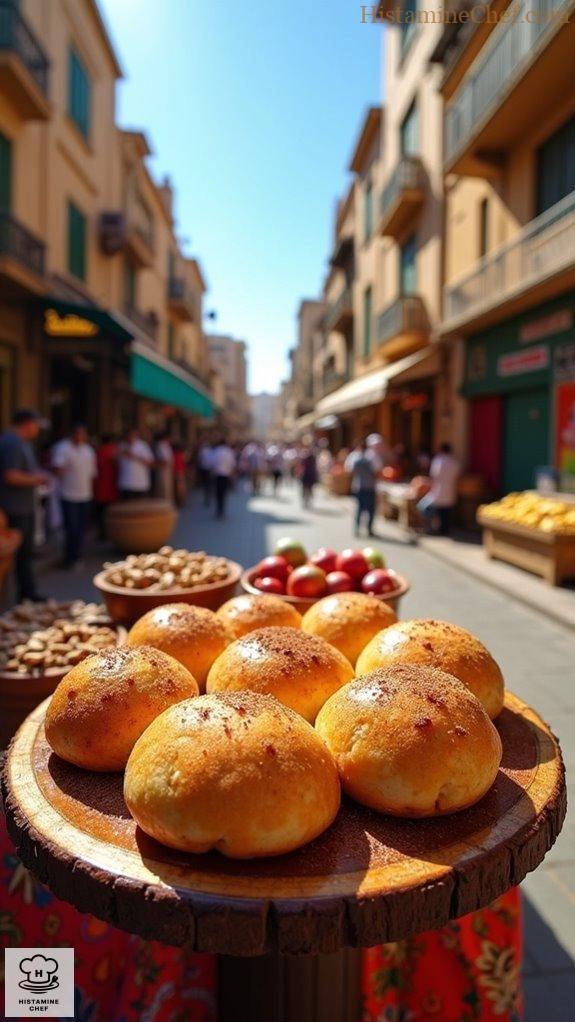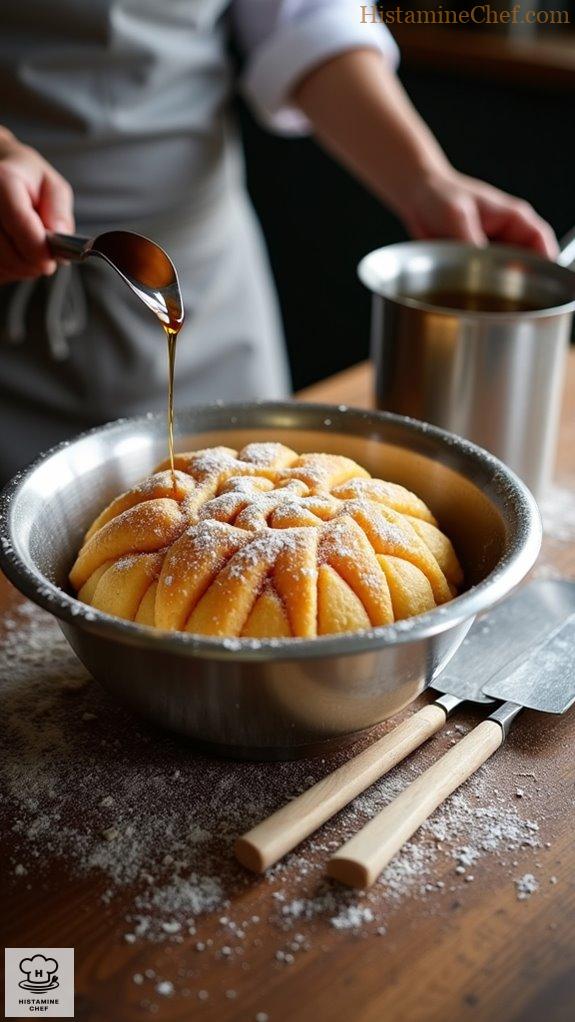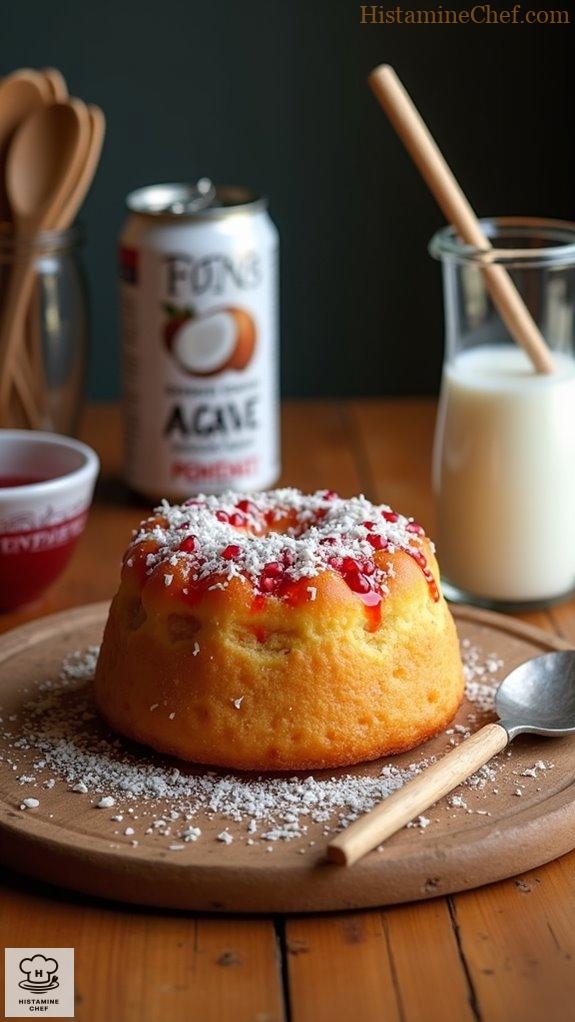I’ve perfected a lower histamine Basbousa that brings the bustling streets of Cairo right to my kitchen! Instead of butter, I use olive oil, and I swap in coconut milk for yogurt. Who knew that simple changes could keep that heavenly sweetness alive? Picture golden semolina cake drizzled with a zesty pomegranate syrup—delicious, right? Ever tried it with coconut flakes instead of nuts? Trust me, your taste buds won’t be disappointed. Stick around to uncover more street-style secrets!
Historic Streets of Cairo

Cairo’s streets pulse with a vibrant street food culture that has deep historical roots, reflecting the city’s rich tapestry of influences over centuries. From bustling markets to vibrant street corners, food vendors offer an array of local delicacies that resonate with the flavors of Egypt’s past.
The origins of street food in Cairo can be traced back to ancient times when the bustling markets, or souks, served as communal spaces where traders sold not just wares but also fresh, hearty meals. These quick bites were both affordable and accessible to the urban populace, transforming into beloved culinary staples, with dishes like koshari and falafel becoming synonymous with Egyptian identity.
One of the delights of this street food culture is basbousa — a semolina cake soaked in syrup, reflecting the tradition of sharing sweet treats among friends and family.
As Cairo continues to thrive, the street food scene remains a reflection of its vibrant culture, bridging generations and celebrating the art of cozy, communal dining amidst the historic backdrop of the city’s winding streets.
Baked in Open-Air Trays

Street vendors cook Basbousa by preparing a thick semolina cake batter, which is poured into open-air trays.
These trays are placed directly over charcoal or wood fires, generating an even heat that cooks the cake while infusing it with a smoky flavor.
The vendors often add sliced almonds or desiccated coconut on top of the batter and carefully monitor the baking process.
Once golden on the surface and firm to the touch, the cake is drenched in a sweet syrup made from sugar and water, adding a delightful sweetness.
Served warm, this traditional dessert is cut into squares, allowing for easy serving to enthusiastic customers.
Ingredients:
- 1 cup semolina
- 1 cup sugar
- 1 cup yogurt
- 1/2 cup melted butter
- 1 teaspoon baking powder
- 1/2 cup almonds (for garnish)
- 1/2 cup sugar (for syrup)
- 1/2 cup water (for syrup)
Cooking Steps:
- Mix semolina and sugar in a bowl.
- Add yogurt and melted butter, stir well.
- Incorporate baking powder, mix until blended.
- Pour batter into an open-air tray.
- Garnish with almonds on top.
- Place tray over charcoal for even baking.
- Cook until golden and firm to touch.
- Drizzle sweet syrup generously before serving.
Bake in a Pan

To bake Street Style Basbousa at home, start by preheating your oven to 180°C (350°F).
In a large mixing bowl, combine semolina, sugar, yogurt, melted butter, and baking powder. Mix well until smooth, then pour the batter into a greased baking pan, spreading it evenly.
To add a personal touch, sprinkle blanched almonds on top and score the surface into diamond shapes for easier serving.
Bake in the preheated oven for about 30-35 minutes or until golden brown.
Once baked, prepare a simple syrup with sugar and water, pouring it over the hot basbousa, allowing it to soak for a few minutes before serving.
Cooking Steps Changed at Home:
- Preheat oven to 180°C (350°F)
- Use semolina flour instead of cake flour
- Combine yogurt with butter for moisture
- Add blanched almonds for decoration
- Score the surface into diamond shapes
- Prepare simple syrup to drizzle
- Allow basbousa to soak before serving
Low Histamine Variation of Basbousa

Histamine intolerance can markedly impact individuals’ ability to enjoy street food, which is often rich in high-histamine ingredients. Many popular street foods contain fermented or processed ingredients that trigger histamine reactions, posing a challenge for those with intolerance. Eating street food like Basbousa can be problematic due to restricted ingredients like yogurt, lemon, and processed sugars listed on the SIGHI list, which can exacerbate histamine sensitivity. Additionally, cross-contamination in street food settings increases the risk of unintended histamine exposure, making it vital for those intolerant to avoid such options. Including delicious low-histamine alternatives can enhance your cooking experience while staying safe from triggers. Moreover, employing smart cooking techniques can further minimize histamine levels in various recipes.
Instructions to Cook Low Histamine Basbousa at Home:
- Use olive oil instead of butter for a histamine-friendly fat.
- Substitute regular sugar with pure agave or honey for sweetness.
- Replace lemon juice with pomegranate juice for added flavor without histamine.
- Avoid using any nuts; instead, use coconut flakes for topping.
- Omit yogurt; use coconut milk as a creamy alternative.
- Validate to use fresh ingredients; avoid processed or canned components.
- Use fresh herbs for flavor, steering clear of chili or cumin.
- Don’t include any fermented ingredients in the recipe.
- Bake in a clean, non-contaminated pan to prevent cross-reactivity.
- Serve with a simple syrup made from water and sugar for moisture.
Video Summary
Basbousa is a traditional Middle Eastern semolina cake, beloved for its unique texture and syrupy sweetness. In this video, we’ll explore two versions of Basbousa: the street style and a home-friendly, low histamine version.
Street vendors prepare Basbousa with flair. They start by mixing fine semolina, sugar, and yogurt in a large bowl. This creates a smooth batter that brings the cake to life. Next, they add melted butter, giving the cake its rich flavor.
In a separate bowl, baking powder is combined with the dry ingredients for a nice rise. The vendors stir everything together until evenly blended. They pour the batter into a greased baking tray, spreading it smoothly.
With a sharp knife, they score the surface into diamond shapes, making it easier to cut. Almonds are placed in the center of each piece. The tray is placed in the oven, preheated to 180 degrees Celsius, for about 30 minutes until golden brown.
Once baked, they douse the hot cake with a syrup made of sugar and water infused with lemon or orange blossom. The syrup soaks in, making each piece delectable.
For a home low histamine version, start with fine semolina and substitute yogurt with almond milk. Use coconut oil instead of melted butter for richness. Prepare baking powder as before, blending the dry and wet ingredients.
Pour into a greased tray, score, but skip the almonds. Bake at the same temperature for 30 minutes. For the syrup, mix equal parts sugar and water, allow to boil, then cool.
The final meal looks golden and inviting, with a soft, syrupy finish. Click the link in the description for the full recipe!


Leave a Reply